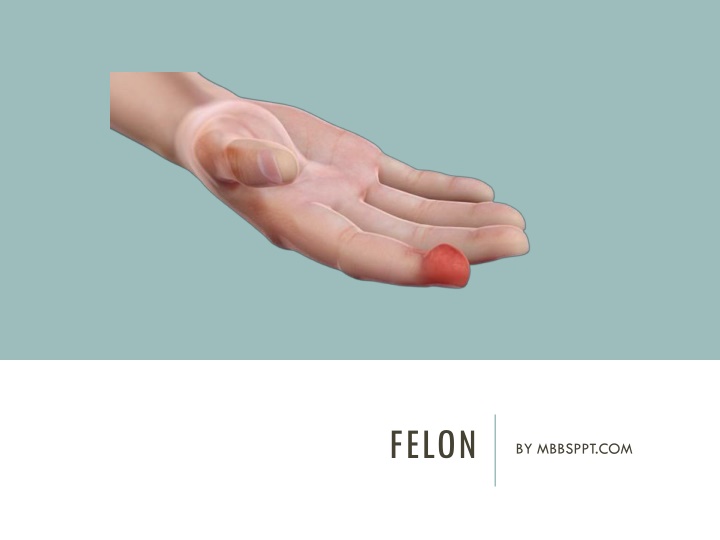
Hand Infections: Causes, Symptoms, Types, and Treatment Options
Learn about hand infections, including causes, symptoms, types, and treatment options. Discover common types like paronychia and felon, along with surgical anatomy and pathophysiology. Early treatment is crucial to prevent severe complications. Find out more about this important topic to protect your hands' health.
Download Presentation

Please find below an Image/Link to download the presentation.
The content on the website is provided AS IS for your information and personal use only. It may not be sold, licensed, or shared on other websites without obtaining consent from the author. If you encounter any issues during the download, it is possible that the publisher has removed the file from their server.
You are allowed to download the files provided on this website for personal or commercial use, subject to the condition that they are used lawfully. All files are the property of their respective owners.
The content on the website is provided AS IS for your information and personal use only. It may not be sold, licensed, or shared on other websites without obtaining consent from the author.
E N D
Presentation Transcript
FELON BY MBBSPPT.COM
HAND INFECTIONS Hand infections can occur due to a number of reasons, including injuries, bites, or delayed treatment. Causes Hand infections can be caused by a variety of bacterial and fungal pathogens, including Staphylococcus aureus and Streptococcus species. They can be caused by injuries, such as bites, puncture wounds, or manicures. Infections can also spread through the blood, which is more common in children, people who are immunocompromised, or people who use intravenous drugs. Symptoms Symptoms of a hand infection include pain, redness, and swelling. Viral infections can cause blisters, itching, or mild burning.
HAND INFECTIONS Types Hand infections can be superficial or deep. Superficial infections affect the skin and subcutaneous tissues, while deep infections can affect the bones, joint spaces, and tendon sheaths. Treatment Early treatment is essential to prevent severe problems, such as loss of strength, stiffness, or tissue loss. Treatment depends on the type of infection and how far it has progressed: Superficial infections: Can be treated with antibiotics, rest, elevation, warm soaks, and splinting. Deep infections: Require surgical intervention, such as incision and drainage, or debridement. Necrotizing fasciitis and gas gangrene: Require immediate surgical intervention.
TYPES OF HAND INFECTIONS Some common types of hand infections include: Paronychia: An infection or inflammation of the nail fold that can be acute or chronic. Felon: An infection of the distal pulp of the finger that often requires surgical drainage. Herpetic whitlow: Caused by the herpes simplex virus and usually resolves on its own.
FELON Infections of intermediate depth spaces. Pulp space infection (FELON). Web spaces infection.
FELON Felon is an abscess of pulp of the finger. It may involve the terminal, middle or proximal volar pulp space. Most commonly involves distal pulp space. Second most common hand infection. Most commonly involves - index and thumb. Results from a minor trauma, ex: finger prick.
SURGICAL ANATOMY Pulp space contains fat - partitioned by septae. Septae are attached from periosteum of phalynx to skin. Terminal pulp space is a closed compartment.
PATHOPHYSIOLOGY Minor Trauma Infection to the Pulp Space Collection of Pus in Space Increase in Pressure in that Closed Compartment Compression of Terminal Artery Gangrene of the Pulp Space Osteomyelitis of Phalynx
FELON Causative Organisms Staph. Aureus (Most Common). Streptococcus. Gram Ve Organisms.
CLINICAL FEATURES OF FELON Severe pain Redness Swelling Fever Tender axillary lymph nodes.
COMPLICATIONS Extend Toward the Phalanx Osteomyelitis. Obliterate Vessels --- Skin Slough or Necrosis. Suppurative Flexor Tenosynovitis or Septic Arthritis of the DIPJ. Extend to form deep Palmar Space Infection. Septicemia.
FELON Investigations: Xray of the part to check for the presence of osteomyelitis. Culture and sensitivity of pus.
FELON Treatment: Antibiotics and analgesics. Definitive treatment: Drainage of terminal pulp space by a longitudinal deep incision. If there is osteomyelitis of the terminal phalanx, it has to be amputated.


